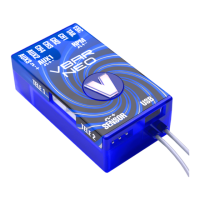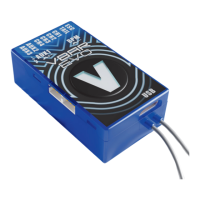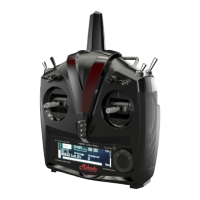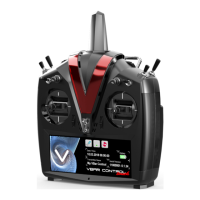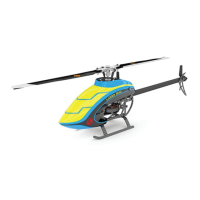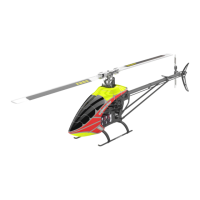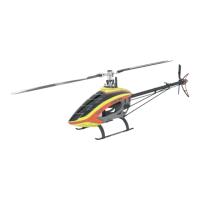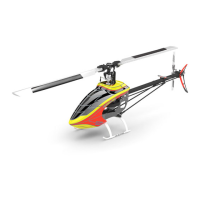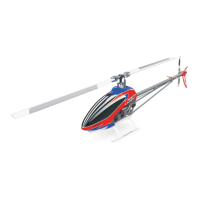8
General Safety
Precautions
VBar Control operates in the 2.4 GHz band, which is in
common use with e.g. industry, science and medical (ISM)
applications. It is widely used for microwave ovens, short-
range wireless communications like WiFi, bluetooth, cord-
less appliances like headphones, or amateur radio. Exces-
sive use of the 2.4 GHz band (like in urban areas) may
degrade the control response and range of VBar Control. If
you experience adverse radio interference, immediately
stop using VBar Control.
In public places, such as airports, hospitals, or racetracks
for example, special limitations may apply.
Transmission is impeded or blocked when any objects are
in the line of sight to the model. This degrades control re-
sponse or even causes the model to go out of control. Al-
ways operate a radio-controlled model so you can safely
control it within line of sight.
Check that all parts and manuals are provided in this box
(see package contents on page 9). Turn on VBar Control
and check that the battery is charged properly. We recom-
mend that you connect your VBar Control to the wall charger,
or to a personal computer using the USB cable to fully charge
the battery. We also recommend to install the VBar Control
Manager (available at www.vstabi.info) to connect VBar
Control to the internet and upgrade to the latest software.
If there are any items or manuals missing, please immedi-
ately contact your local dealer or the service department of
Mikado Model Helicopters.
⚠ Warning Never use VBar Control on rainy days or if there
is any precipitation. Electronics may malfunction if they get
damp or wet.
⚠ Warning Never disassemble or modify VBar Control be-
yond what is described in this manual. Heat, re or an elec-
tric shock may cause injury or physical damage.
⚠ Warning The power unit (engine/motor/gears) as well as
rotating parts (rotor head and blades, tail rotor head and
blades etc.) may start up at high speeds, causing danger.
Always turn on VBar Control rst, and make sure the throt-
tle stick/switch is set to the lowest/motor off position, then
turn on the receiver/model. Make sure that all fail safe pre-
cautions regarding an electric speed controller are met.
Connect a ight pack only when sticks and switches are set
to lowest/motor off position. When turning off power, always
turn off the receiver/model rst, also disconnect the ight
pack. Note: as a safety precaution, VBar control can only
be turned off after the connected VBar Flybarless controller
and receiver have been turned off.
⚠ Warning Pay full attention when setting up an electronic
speed controller (ESC) or an IC engine. Injury or physical
damage can be caused.
Do not start an IC engine with the throttle set to a high rpm
position. Injury or physical damage can be caused.
⚠ Warning When using components from other manufactur-
ers, you must make sure that all components in the system
are compatible with each other. Especially the power sup-
ply of the radio control system as a whole must be suitable
to meet the needs of all appliances connected. Malfunc-
tioning components or components drawing too high a cur-
rent, or generating back voltages, may disrupt the safe op-
eration of the radio control system as a whole.
⚠ Warning VBar Control and the VBar Control Receiver as
well as the VBar and the other components are sensitive to
shock. Avoid hard impacts. Do not drop them. This may
cause malfunction.
⚠ Warning If you detect that control degrades, stop operation
of your model, check battery and general condition. The
model may get out of control, causing injury or physical
damage.
⚠ Warning Never operate the model next to known radio inter-
ference, passing vehicles or people, next to high-voltage
power lines, buildings, and be careful in mountainous areas.
The model may get out of control, or malfunction may oc-
cur, causing injury or physical damage.
⚠ Warning Every electronic component that has gone damp
or wet may malfunction at any time, even if it seems to work
again normally after being fully dried. Do not continue to
use such components and contact the service and support
of the company for the product for a check-up.
☝ Attention Do not spill fuels or liquids from the exhaust of a
combustion engine on VBar Control: they can leave perma-
nent marks on surfaces. Remove such residues immediately.
☝ Attention Before any radio control operation, check the
following:
» Are the batteries charged fully/sufciently?
» Is there enough fuel in the tank?
» Are any liquids spilled on the electronics, like water or fuel?
» Make sure all linkages are secure and no slop or binding
occurs in operation.
» Make sure that the overall vibration level on the model is
low, and that all control functions work reliably when the
power unit and drive train are running at the expected rpm.
» Make sure all fail safe precautions are met: in case of a
loss of control the motor/engine must turn off.
» When running the power unit/drive train, keep clear of
rotating parts and mind the danger of main or tail rotor
blades spinning.
» On the rst ights of a newly set up model, select a safe
place for takeoff, and test the control functions and oper-
ation close by but at a safe enough distance for several
minutes. Do not y at great distances.
» Familiarize yourself with safety precautions, such as how
to switch off the motor in case of any unwanted/uncon-
trolled operation. This is to take the energy and vibration
out of the system. Be prepared to attempt an emergency
landing/autorotation.
☝ Attention VBar Control will warn if the battery level falls
below 3.5 V. VBar Control will switch off automatically when

